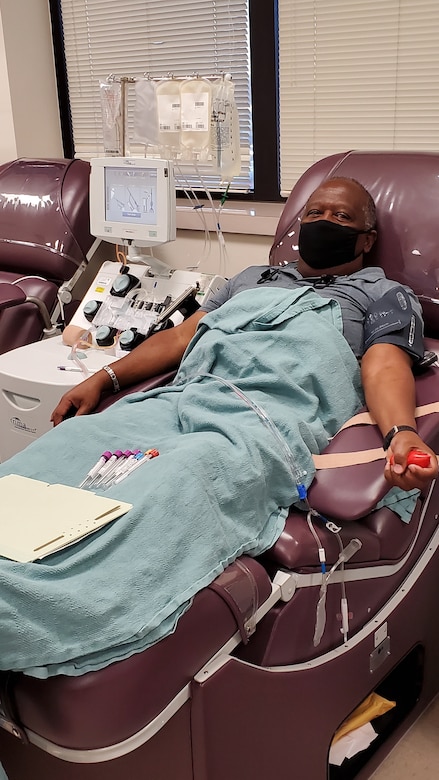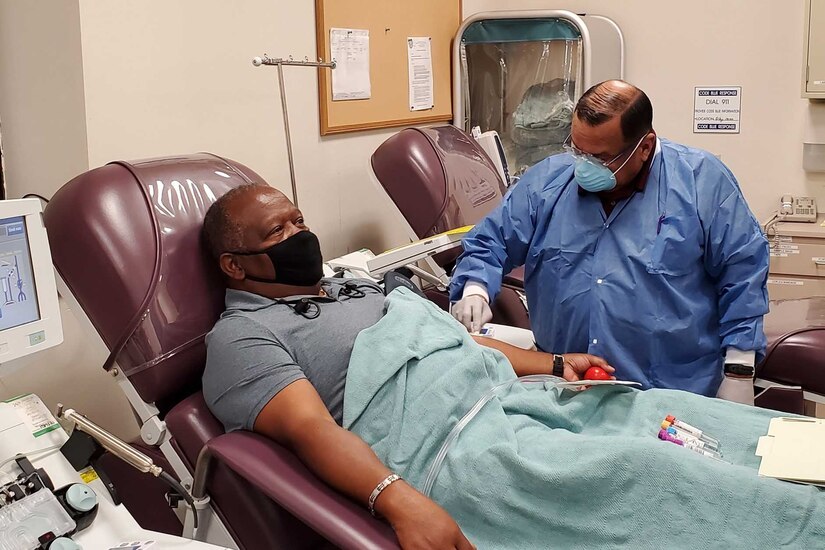Sept. 15, 2020 | , Brooke Army Medical Center
Thefety Tibbs, who was among the first COVID-19 patients treated at Brooke Army Medical Center, Joint Base San Antonio-Fort Sam Houston, Texas, is now among the first of BAMC's former patients to donate convalescent plasma, which is currently being explored as a potential treatment for COVID-19.
Tibbs said the evening of April 10, 2020, he wasn't feeling well. He had already taken medicine for a headache, but decided to go to the emergency room due to relentless sinus pressure. After receiving x-rays and an initial diagnosis of pneumonia, the staff completed a swab culture. Shortly after, he was informed that he had tested positive for COVID-19. He was quickly moved to a COVID-specific ward.

"It was a challenge from then on," Tibbs said. "I really didn't know what to expect. You see it on the news, and you see people dying. And then they took care of me. I was worried that first night, but they took care of me all the way through."
He made a full recovery and was released 10 days after he had been admitted. He received a request about two weeks later to donate convalescent plasma. After some internal debate, he decided to accept the request.
BAMC continues to seek donations of convalescent plasma from eligible donors. The donations are specifically for the center's patients, and the program is being led by the Armed Services Blood Program. The science behind the potential treatment involves how the body reacts to the virus and speeds up the recovery.
When someone contracts a virus, that person's immune system creates antibodies to fight the virus. For people who successfully fight a virus, their plasma will now contain infection-fighting antibodies called "convalescent plasma." Thus, patients who have fully recovered from COVID-19 can donate their plasma as a potential treatment for others who are now fighting the same virus.
Anyone who chooses to donate convalescent plasma goes through the same process as someone who donates regular plasma, but there are some extra requirements for donors to be eligible to donate convalescent plasma. Donors must be at least 17 years old, weigh at least 116 lbs. and be in good general health. Additionally, to donate convalescent plasma, volunteers must have already had COVID-19 and be fully recovered for at least 14 days. This means donors must be symptom-free for the full two weeks before they will be considered for donation, and all donations are screened for COVID-19 antibodies.
"All potential CCP donors must be prescreened before I can set them up for an appointment," said Mark Salcedo, the blood donor recruiter for the JBSA Fort Sam Houston Armed Services Blood Program. "If the donor is prescreen eligible, I'll forward to our medical director for his review. He reviews their medical history and either approves or disapproves their donation. Once approved, I can schedule them for a plasma appointment. The staff does a lot on the front end of a CCP donation to protect the donor's health and the safety of the military's blood supply."

There are two ways eligible donors can give convalescent plasma. The first is by donating whole blood. This yields one dose of convalescent plasma. The process takes about 15 minutes, and donors can return to donate every 56 days. The second is by donating plasma. This yields about three to four doses of convalescent plasma. The donation takes about 45 minutes. For their safety, the staff at the Akeroyd Blood Donor Center require a minimum of 28 days between convalescent plasma donations.
"I wanted to try and help somebody else who has the virus," Tibbs said. "It was very efficient, so I decided to keep on going in. The team is excellent. They made me feel very comfortable."
Salcedo said there are currently about 150 donors in their system, but they are still looking for more. Anyone who is interested, and eligible, can donate at the Akeroyd Blood Donor Center at 1240 Harney Rd. on JBSA Fort Sam Houston. Interested donors can contact Mark Salcedo at 210-295-4655 or 210-295-4109. For more on the Armed Services Blood Program, click here.






No comments:
Post a Comment